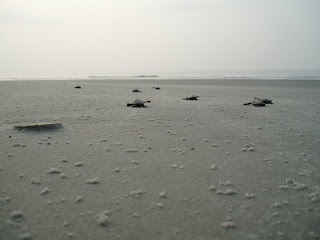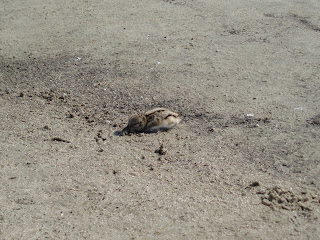 |
| Screenshot of her nesting history by DNA |
An inventory has been completed on SM01, with poor results.
 |
| Nest contents of SM01 |
The good news, however, is that NB20 emerged on July 25, at 63 days. Steve counted about 20 crawls to the water. Today, I found two hatchlings at the surface. I helped them down the beach, as it was low tide. (I am beginning to feel like it's always low tide when I have to release hatchlings during the day.) Fortunately, it was cool and overcast. I watched them crawl to the water and swim off. They are not nearly as agile as loggerheads, or at least that's my experience. Their front flippers are so cumbersome that both crawling and swimming takes a lot of effort. Look on the side bar for video and in the 2011 album for more photos. I continued on survey, and returned some time later to check on the nest once more before calling it a day. I found another hatchling emerging, but with a ghost crab attacking it. I scared the crab off and helped the hatchling out of the screen. Again I spent some time with the hatchling, allowing it to slowly crawl down the beach and slowly swim off. It's a wonder that any of them survive.
This may be one of a few successful emergences of leatherback hatchlings so far in Georgia's history. Given the rainy, cool conditions, there very likely will be more hatchlings emerging today and tonight. I hope these little turtles help pass on mom's genes and continue to bring more leatherbacks to Ossabaw.


































